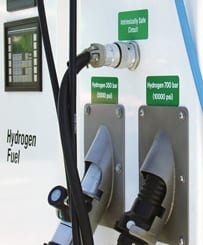US aims to speed the development of hydrogen fuel stations
December 18, 2015Hydrogen fuel infrastructure is becoming a priority as fuel cell vehicles begin coming to the US
Fuel cell vehicles are coming to the United States, with drivers seeing more and more of these vehicles becoming available. While fuel cell vehicles are becoming more common, the number of hydrogen fuel stations available to consumers is quite low. Lacking infrastructure, among other issues, is making fuel cell vehicles less attractive to consumers, who see the low number of fueling stations and note that actually owning a fuel cell vehicle would be somewhat inconvenient.
HyStEP will reduce the time it takes to commission hydrogen fuel stations
Sandia National Laboratories and the National Renewable Energy Laboratory aim to solve this problem. The two organizations have developed the Hydrogen Station Equipment Performance (HyStEP) device. The device is designed to reduce the time it takes to commission new hydrogen fuel stations from months to a matter of one week. By lowering the time to commission hydrogen fuel stations, many more of these stations are expected to take form in the United States.
Sluggish validation practices slow the expansion of a hydrogen infrastructure
 The current practice associated with the commissioning of hydrogen stations is quite slow, with the process often taking several months. The process is so slow because each automaker conducts their own validation tests regarding the performance of hydrogen fuel dispensers. Each of these tests takes approximately two weeks, and with all automakers doing this, the time to commission a hydrogen stations is quite long. Streamlining the process will ensure that the country’s hydrogen infrastructure will be able to support the numerous fuel cell vehicles that will be coming to the country’s roads.
The current practice associated with the commissioning of hydrogen stations is quite slow, with the process often taking several months. The process is so slow because each automaker conducts their own validation tests regarding the performance of hydrogen fuel dispensers. Each of these tests takes approximately two weeks, and with all automakers doing this, the time to commission a hydrogen stations is quite long. Streamlining the process will ensure that the country’s hydrogen infrastructure will be able to support the numerous fuel cell vehicles that will be coming to the country’s roads.
Country must ensure that its hydrogen fuel stations are actually operational
Hydrogen stations do exist in the U.S., with the majority of these stations being located in California. Notably, the country must make sure that not only are there enough fueling stations to support fuel cell vehicles, but they must also ensure that these stations are actually working. In California, many of those driving fuel cell vehicles have reported that the fueling stations that they use are actually inoperable.

 With over 15 years of reporting hydrogen news, we are your premier source for the latest updates and insights in hydrogen and renewable energy.
With over 15 years of reporting hydrogen news, we are your premier source for the latest updates and insights in hydrogen and renewable energy.